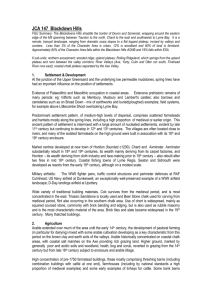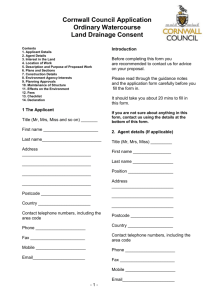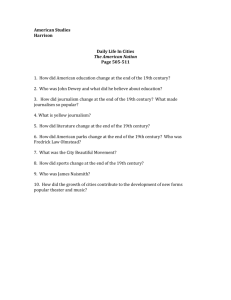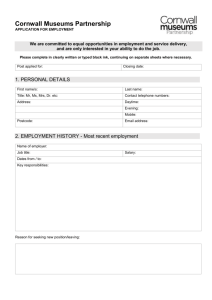JCA 152 Cornish Killas, JCA 154 Hensbarrow, and JCA 155
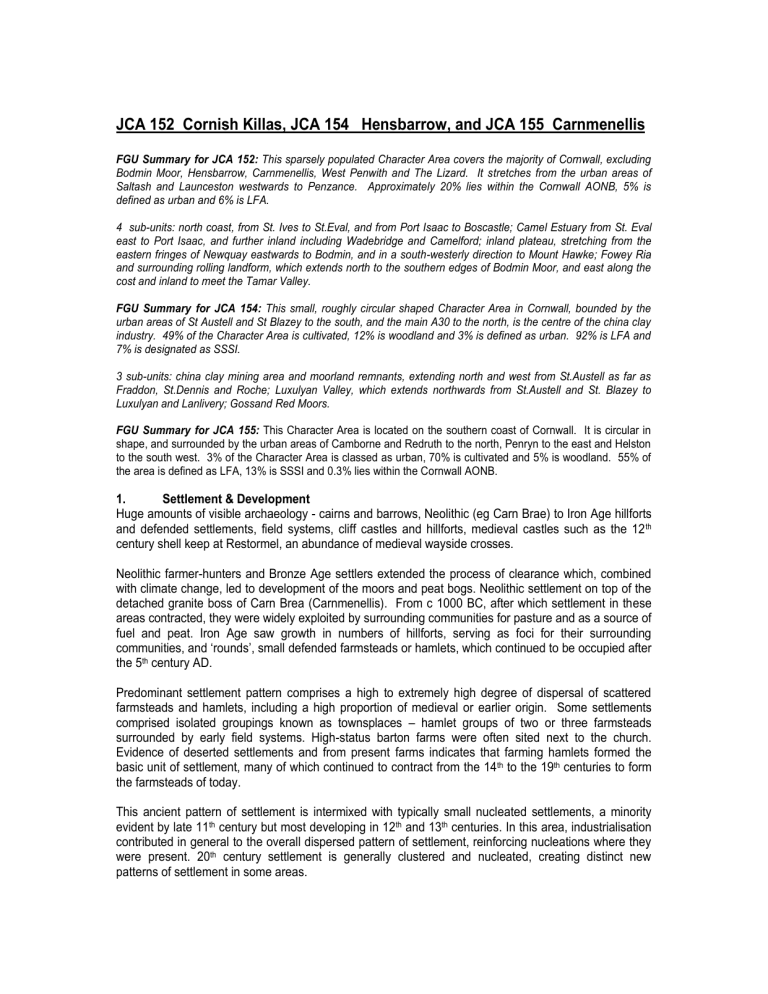
JCA 152 Cornish Killas, JCA 154 Hensbarrow, and JCA 155 Carnmenellis
FGU Summary for JCA 152: This sparsely populated Character Area covers the majority of Cornwall, excluding
Bodmin Moor, Hensbarrow, Carnmenellis, West Penwith and The Lizard. It stretches from the urban areas of
Saltash and Launceston westwards to Penzance. Approximately 20% lies within the Cornwall AONB, 5% is defined as urban and 6% is LFA.
4 sub-units: north coast, from St. Ives to St.Eval, and from Port Isaac to Boscastle; Camel Estuary from St. Eval east to Port Isaac, and further inland including Wadebridge and Camelford; inland plateau, stretching from the eastern fringes of Newquay eastwards to Bodmin, and in a south-westerly direction to Mount Hawke; Fowey Ria and surrounding rolling landform, which extends north to the southern edges of Bodmin Moor, and east along the cost and inland to meet the Tamar Valley.
FGU Summary for JCA 154: This small, roughly circular shaped Character Area in Cornwall, bounded by the urban areas of St Austell and St Blazey to the south, and the main A30 to the north, is the centre of the china clay industry. 49% of the Character Area is cultivated, 12% is woodland and 3% is defined as urban. 92% is LFA and
7% is designated as SSSI.
3 sub-units: china clay mining area and moorland remnants, extending north and west from St.Austell as far as
Fraddon, St.Dennis and Roche; Luxulyan Valley, which extends northwards from St.Austell and St. Blazey to
Luxulyan and Lanlivery; Gossand Red Moors.
FGU Summary for JCA 155: This Character Area is located on the southern coast of Cornwall. It is circular in shape, and surrounded by the urban areas of Camborne and Redruth to the north, Penryn to the east and Helston to the south west. 3% of the Character Area is classed as urban, 70% is cultivated and 5% is woodland. 55% of the area is defined as LFA, 13% is SSSI and 0.3% lies within the Cornwall AONB.
1. Settlement & Development
Huge amounts of visible archaeology - cairns and barrows, Neolithic (eg Carn Brae) to Iron Age hillforts and defended settlements, field systems, cliff castles and hillforts, medieval castles such as the 12 th century shell keep at Restormel, an abundance of medieval wayside crosses.
Neolithic farmer-hunters and Bronze Age settlers extended the process of clearance which, combined with climate change, led to development of the moors and peat bogs. Neolithic settlement on top of the detached granite boss of Carn Brea (Carnmenellis). From c 1000 BC, after which settlement in these areas contracted, they were widely exploited by surrounding communities for pasture and as a source of fuel and peat. Iron Age saw growth in numbers of hillforts, serving as foci for their surrounding communities, and ‘rounds’, small defended farmsteads or hamlets, which continued to be occupied after the 5 th century AD.
Predominant settlement pattern comprises a high to extremely high degree of dispersal of scattered farmsteads and hamlets, including a high proportion of medieval or earlier origin. Some settlements comprised isolated groupings known as townsplaces – hamlet groups of two or three farmsteads surrounded by early field systems. High-status barton farms were often sited next to the church.
Evidence of deserted settlements and from present farms indicates that farming hamlets formed the basic unit of settlement, many of which continued to contract from the 14 th to the 19 th centuries to form the farmsteads of today.
This ancient pattern of settlement is intermixed with typically small nucleated settlements, a minority evident by late 11 th century but most developing in 12 th and 13 th centuries. In this area, industrialisation contributed in general to the overall dispersed pattern of settlement, reinforcing nucleations where they were present. 20 th century settlement is generally clustered and nucleated, creating distinct new patterns of settlement in some areas.
Major industries were fishing, quarrying and mining. Numerous ports specialising in fishing and associated industries, net-making and fish-curing, as well as trading from the medieval period. Many ports having benefited from a doubling of coastal trade between 1780s and 1840, there being some 16 th and 17 th century town houses (eg Penzance, Penryn, Fowey) but most building dating from later 18 th century.
Rapid growth from 18 th to mid 19 th centuries of rural industrial communities associated with the development of tin, copper and china clay mining. Expanding or new settlements were particularly dense in the Camborne/Redruth area, and many were colonised by miners’ families out of unimproved moor land. Other settlements mushroomed as a result of industrial activities such as founding and smelting – such as Hayle.
Engine houses, arsenic calcifiers and other remains associated with the mining of tin, copper, arsenic and wolfram - sometimes all together, as at Gunnislake. Mineral extraction and mining sites of global importance as the centre of an industry and deep-mining technology exported to many other parts of the world. Ancillary industries – tin smelting, production of steam engines, rock drills and other equipment that enabled deeper mining in Cornwall and the world – concentrated in Hayle, Camborne and Redruth.
Gunpowder works at Kennal Vale supplied explosives to mines.
Hensbarrow: Most of the towns and larger villages (e.g. Luxulyan, St Blazey, Bugle) are associated with the mining industry, and specifically the discovery of china clay deposits in the 1750s, and lie towards the outer parts of this area. Tips and pools occupy substantial areas, and there are other remains such as engine houses.
Terrace houses, and Methodist chapels are major characteristics of the industrial areas.
Cornwall has with south Wales the principal concentration of Methodist chapels in Britain.
Industrial activity led to the development and burgeoning wealth of the coastal ports and small towns, and stimulated the development of large gentry houses and accompanying parks on the most sheltered sites especially to south. Major port and administrative centre at Truro, expanded considerably from late
18 th century. Other market towns, such as St Austell, experienced strong growth in the same period.
Poor road communications between most of the major towns as late as the early 19 th century, and despite the growth of mineral tramways linking the orefields and clay mining areas to coastal ports,
Cornwall was the last English county to be linked to the main railway system (construction of the Royal
Albert Bridge over the Tamar in 1859).
As industry has declined since the late 19 th century, so has the importance of tourism risen. Copper mining collapsed drastically in the late 1860s and 1870s. By the early 20 th century the Cornish fishing industry, where the mostly family-run companies were deeply affected by the sudden decline of pilchard shoals, could not compete with the more heavily capitalised and steam-powered drift-net operators from the East Coast.
Most common traditional building materials are slate and granite, often whitewashed and with slate roofs and sometimes slate hanging to walls. Cob formerly widespread, but often found used to build upper floors of rural and town buildings into 19 th century. Limited use of brick, largely confined to ports such as Truro and Fowey.
2. Agriculture
Generally covered by well-drained brown earth soils, of moderate fertility with patches of good fertility.
The class of small, independent tenant farmer, so characteristic of Cornwall in the eighteenth and nineteenth centuries, had evolved from peculiar tenancy agreements operated by the Duchy of Cornwall in the medieval period.
Cattle rearing was the principal form of farming, with arable and stock historically concentrated in some coastal areas, principally around Padstow and Wadebridge to the north and along the south coast. The improved rail networks from the later 19 th century facilitated the development of market gardening in the area around Falmouth, and of liquid milk production.
The dominance of livestock production by the early 19 th century involved a majority of the land being laid to grass, and turnips and other fodder crops being grown on arable to feed cattle and in turn enrich the land with their manure. Some of the more fertile brown earths in low-lying areas (eg the Lynher
Valley) were more intensively cultivated. Cattle numbers increased still further from the 1870s.
Pre-18 th century farmstead buildings predominantly comprise farmhouses, with some dating to extensive programme of rebuilding starting in late 16 th century but most dating from late 17 th and especially late 18 th century. Archaeological evidence for pre-18 th century farming hamlets with longhouses and small barns, linear farmsteads being characteristic of the later 18 th and 19 th centuries on smaller farms. Widespread rebuilding of farmsteads from late 18 th century, earlier fabric being more common to the east. Some bank barns dating from late 18 th to mid 19 th centuries, and other 2-storey combination barns very similar to bank barns but accessed by external steps. Many farmsteads had cattle yards for fattening added in the mid-late 19 th century. Open-fronted shelter sheds and some linhays, facing into cattle yards. Enclosed cowhouses, generally of 19 th century date, and some detached granaries.
Predominant farmstead plans comprise dispersed layouts. Some enclosed courtyard plans, mostly on larger and high-status farms, some as developed or remodelled in the early-mid 19 th century with wheel houses for threshing machinery. Some enclosed courtyard plans, mostly on larger and high-status farms, some as developed or remodelled in the early-mid 19 th century with wheel houses for threshing machinery.
3. Fields and Boundary Patterns
Hedgerows and Cornish hedgebanks, some stone-faced.
The landscape is generally one of ancient enclosure, formed in the medieval period and in some cases earlier. Farmsteads were sited in villages, in hamlets or individually with access to infield areas ploughed into strip fields, the outfield areas located in large fields or enclosures being subject to intermittent cultivation and sometimes retaining strip fields. Evidence from at least 14 th century (for example around Trevalga between Tintagel and Boscastle) for piecemeal enclosure, generally complete by 16 th century, characteristically retaining curved shapes of medieval strips to at least one of the longer sides. Larger-scale enclosure of this type is also found, representing enclosure at the outset of larger groups of strips. Some medieval fields – principally on high-status barton farms but also including smaller-scale closes added to existing farms - enclosed from the outset, these typically retaining more square forms with generally irregular boundaries, occasionally with post-medieval subdivision within them.
Post-medieval fields also widely scattered over the area. Rural-industrial areas associated with typically small-scale enclosures of miner-farmer smallholdings, for example around Scorrier and on Buller Downs in Illogan. Larger-scale extensions to earlier farms on former margins of downs such as east of Hayle and south of Camborne. Regular and large-scale enclosures on rough ground, relating to establishment of new farms in late 18 th and 19 th centuries, for example on former heathland north-east of Redruth and near St Agnes. This type of enclosure is mostly concentrated in a band to the west of Torquay and on the inland plateau, from St Eval on the north coast around Bodmin to the Taphouse area.
20 th century enclosure, including areas of boundary loss and encroachment onto heath, concentrated in east of the area.
On the granite masses of Hensbarrow and Carnmenellis are the prominent remains of prehistoric field patterns.
4. Trees and Woodland
The landscape was cleared of most woodland cover by approx. 1000 BC.
The Killas comprises an undulating slate plateau with little woodland and few hedgerow trees, ancient woodland being concentrated in the valleys and in the lower reaches of the Camel valley. Estate landscapes of well-managed woodlands and pasture commonly border the coastal inlets to the south.
Carnmellis: Wet willow woods in the shallow valleys on the higher hills and deciduous woods lower down.
5. Semi-Natural Environments
The shallow estuaries and sand dune expanses of the north coast are striking. On the fringes of the upland granite areas there are patches of heathland.
Rise of sea level between 7 and 3000 BC reduced land area by 25%.
Long standing areas of grassland and unimproved pasture are both rich in species and in the surviving visible evidence of earlier cultivation and settlement (from an abundance of prehistoric remains including field systems to ridge and furrow and village earthworks of the medieval and post-medieval periods).
6. River and Coastal Features
Defences –16 th to early 20 th century coastal defences at for example Rame Head, St Mawes and
Pendennis
Successive development of the principal forts defending the harbours and estuary mouths eg:
Catherine's castle Falmouth and St Mawes castles - Tudor blockhouses and artillery castles, with later batteries for RML and later coatal artllery pices, searchlight emplacesments. etc.
Medieval bridges such as Helland, Lerryn and Ruthern, Starabridge. Masonry bridges are part of the two main concentrations of medieval-18 th century bridges in England (Devon and Cornwall, and north and west Yorkshire).
Railway engineering works: for example Treffry Viaduct: granite viaduct 660 ft long carrying both water and mineral railway across the Luxulyan Valley. Built 1839-42 by J T Treffry. The railway ran from St
Blazey to Newquay; the aqueduct carried water in a leat to Pont's Mill a mile away near Tywardreath
Highway
D-Day landing craft maintenance sites at Saltash and at Mylor Harbour, Carrick Roads (scheduled)
Hayle Harbour - once the shipping port for the majority of the stream engines exported around the country and other orefields throughout the world (Australia, Peru, North America, Spain).
Important early Christian site and later castle and country house at St Michael's Mount, which also sites within a nationally-significant example of a WWII defended area.
